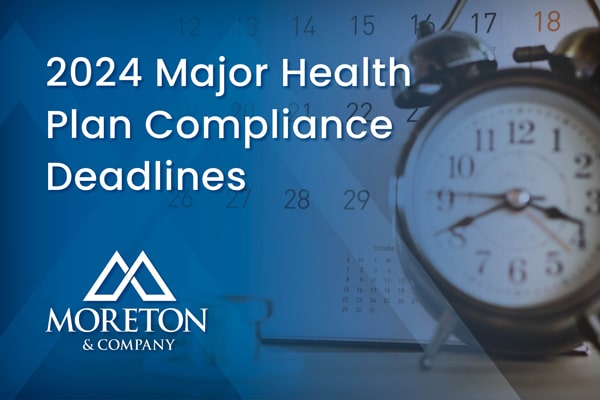Upcoming Prescription Drug
Reporting Requirement

Client Alert Applies To: Self-Funded, Fully-Funded, Large Group, and Small Group
The Consolidated Appropriations Act, 2021 included several new health transparency rules, including a requirement that health plans provide specific information regarding prescription drugs covered by the Plan (1). The first report covers calendar years 2020 and 2021 (regardless of plan or policy year) and is due December 27, 2022. Group health plan sponsors (i.e., employers), particularly those who sponsor self-funded plans, should begin working now with their Plan’s third-party administrator (TPA) and/or prescription drug providers (i.e., PBMs) to meet this deadline.
Who Must Report?
The prescription drug reporting requirements apply to both fully insured and self-funded group health plans and insurance issuers offering group or individual coverage. The requirements apply to ERISA plans, non-federal governmental plans, federal plans and church plans. A self-funded health plan can contract with a vendor to fulfill the Plan’s reporting requirements but will remain responsible for the reporting. A fully insured plan may shift the responsibility for reporting by entering into a written contract under which the insurance carrier assumes responsibility for the reporting. Excepted benefit plans (i.e., stand-alone dental and benefit plans) and account-based plans (HRA, FSA) are not required to report.
What Information Must Be Reported?
Plan sponsors will need to report on two categories of information, Plan Lists and Data Lists:
Plan Lists (general information regarding the Plan)
- Identifying plan information (e.g., plan number, issuer name, plan sponsor, reporting entity)
- Beginning and end dates of the plan year
- Number of participants and beneficiaries covered on the last day of the plan year
- Each state in which the Plan or coverage is offered
Data Lists (prescription drug and Plan spending information)
- Enrollment and premium information, including average monthly premiums paid by employees versus employers;
- The Plan’s total health care spending by category (hospital care, primary care, specialty care, prescription drugs, wellness services). This element focuses primarily on medical benefits (including those prescription drugs covered under the medical benefits portion of the plan, such as in-patient administered drugs) rather than prescription drugs covered under the prescription drug portion of the plan;
- The 50 most frequently dispensed brand name drugs during the reporting year;
- The 50 most costly drugs during the reporting year;
- The 50 drugs with the greatest increase in cost over the previous year;
- Rebates, fees, and other remuneration received by the Plan in each therapeutic class of drugs, as well as the 25 drugs with the highest rebates.
The Plan must also include a narrative that describes the impact of prescription drug rebates on plan premiums and cost-sharing provisions, along with certain other information.
Interestingly, the reporting instructions indicate that if a vendor is providing the Plan’s reporting, the vendor must provide Plan List information by plan, but can aggregate individual Data List plan information (subject to certain limits) for a number of plans. For example, a self-funded plan TPA could aggregate the Data List information of all the plans it administers by state and report only that aggregated information.
How Do Plans Report?
All required reporting must be done through CMS’ Health Information Oversight System (HIOS).The first report (for 2020 and 2021) is due December 27, 2022.Thereafter, plans must report for each calendar year by June 1st of the following year.
Practical Challenges & Issues in Reporting
For fully insured employers, compliance is fairly straightforward. As long as the plan sponsor contracts with the insurance carrier to provide the required reporting, the carrier is responsible. Self-funded employers face more of a challenge, particularly if pharmacy benefits under the Plan are handled by a vendor other than the plan’s TPA. A self-funded employer plan under which medical and pharmacy benefits are provided through its TPA will likely contract with the TPA for reporting services. If coordination with additional vendors is needed to compile the required information, the employer will be responsible for coordinating among vendors and gathering the necessary details.
For employers who sponsor a self-funded plan where pharmacy benefits are carved out and handled by an independent Prescription Benefits Manager (PBM), reporting becomes more complicated. The PBM will likely handle the bulk of the reporting. However, both Plan List and Data List categories include certain general plan information that the PBM may not have. The employer will be responsible for either providing this information to the PBM (assuming the PBM vendor is willing to report on elements other than the prescription drug benefits) or submitting the information themselves. To submit information to CMS, a reporting party must register with HIOS, which can take approximately two weeks. While many plan vendors (such as PBMs and TPAs) already have HIOS accounts, most plan sponsors do not. Employers who may have to submit required items directly should begin preparation early, to ensure the reporting deadline is met. Also, be aware that many TPAs and PBMs are charging additional fees for this reporting.
Conclusion
Given the limited time until the reporting deadline, plan sponsors should begin working with their insurance carriers, TPAs, PBMs and other plan vendors now to ensure this new reporting requirement is completed on a timely basis. For employers who must submit some or all of the information themselves, detailed instructions on reporting (and other information) can be found here: cms.gov/CCIIO/Programs-and-Initiatives/Other-Insurance-Protections/Prescription-Drug-Data-Collection. Please contact your Moreton & Company account team for further information and assistance in coordinating with plan vendors.
(1) The Transparency in Coverage (“TiC”) regulations also require certain reporting regarding plan prescription drug benefits; however, the TiC requirements have been indefinitely extended to avoid duplication.
© 2022 by Moreton & Company. This Client Alert is intended to alert recipients to recent legal developments. It does not constitute the rendering of legal advice or recommendations and is provided for your general information only. If you need legal advice upon which you can rely, you must seek an opinion from your attorney.


